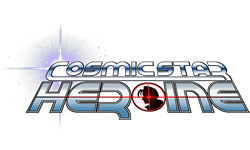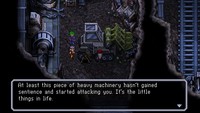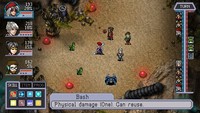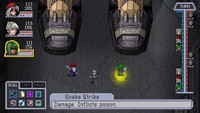|
|

|
PLATFORM
|
PC
|
BATTLE SYSTEM
|

|
INTERACTION
|

|
ORIGINALITY
|

|
STORY
|

|
MUSIC & SOUND
|

|
VISUALS
|

|
CHALLENGE
|
Moderate
|
COMPLETION TIME
|
Less than 20 Hours
|
|
OVERALL

|
+ Interesting, intricate battle system
+ Above-par "16-bit" graphics
+ Good musical accompaniment
- Characters lack dimension
- Still buggy on occasion
|
Click here for scoring definitions
|
|
|
Last fall I had the opportunity to write about the Early Access version of Cosmic Star Heroine, and found it to be an enjoyable experience despite some hiccups. When the full release rolled out last month, I felt obliged to start a new game file and play through to the end. Did my opinion of the game change any? Well, that's both yes and no. As always, the devil is in the details.
CSH is a game that wears its inspirations openly. Even without seeing the developers' comments about emulating the atmosphere and experience of Phantasy Star and Chrono Trigger, it's obvious where much of its aesthetic comes from. The player is led on a romp across a star system far, far away, with its three inhabitable planets full of mystery and danger, in a quest to prevent Very Bad Stuff™ from happening. The titular heroine is Alyssa L'Salle, top operative for the Agency of Peace and Intelligence, and if the Orwellian moniker wasn't clue enough, it becomes obvious early on that some higher-ups are uncomfortably zealous about the agency's goals.
As a love letter to the 16-bit generation, there's a certain standard to be had for the story, and unfortunately CSH meets it. Games from the 90s are rarely known for their gripping, cohesive, and well-constructed plots, after all, and with a full roster of ten playable characters, there was no reasonable way for Zeboyd to flesh them all out without extending the game's content to three or four times the ten hours needed to beat it (not to mention prolonging an already delayed production schedule). As it stands, the cast is varied, interesting, but not incredibly deep. One or two of them could be removed without duly changing the plot in any way. Not even the villains are immune to this, as there are several supporting baddies whose motives are never explored, and who don't even appear in a fight once.
On the other hand, this is a game that sends the player crashing pinball-like between multiple planets, fending off crazed defense systems, maniacal AIs, terrorits plots, government conspiracies, assassinations, giant robots, giant robots fighting giant monsters, and a whole lot of other crazy stuff besides. The cast includes psychic sharpshooters, phantom detectives, alien bounty hunters, indie punk musicians, and a literal disco machine with a tendency to short circuit. Again, while there's very little depth, there's plenty of breadth.
 It's the little things, really.
It's the little things, really.
|
|
The other major way in which CSH greatly resembles its inspirations is, unfortunately, in the bug department. While the worst of them have been steadily patched out of existence since the initial release date, there are still spots where the player can get Alyssa stuck on bits of scenery. Thankfully, those were the worst that I personally encountered, but they still constitute an element of the experience which should have been worked out before the game was greenlighted. There are also occasional spelling and grammatical errors in dialogue, but only sporadically.
Now that the primary negative is out of the way, it's time to discuss some of the stuff that CSH got right. First, there's combat. CSH takes a page from Chrono Trigger and has all of its battles happen directly in the field with the enemies visible beforehand. While this does mean that the game has a set number of encounters for its entire length, there is also an option to replay battles in VR mode for slightly reduced rewards. Combat moves and options are separated into personal skills, items, and programs.
Each character gets eight slots for personal skills, though the total amount available to them grows steadily as they level up. Unless specifically stated in the description, each skill is locked after one use and cannot be used repeatedly. The eighth skill is always a resting option, often with extra bonuses involved, which will recharge any locked skills. Combined with an ever-climbing style meter and a Hyper Gauge that regularly puts the character into power attack mode, battle becomes a matter of juggling available skills and timing the buffs for maximum effect. There is no such thing as simply pressing A to attack over and over, and some level of thought is required for most battles.
 Here, kitty-kitties...
Here, kitty-kitties...
|
|
Programs are special skills encoded in shields which anyone can equip, but there are stat requirements for unlocking most of them. These abilities may imitate certain character skills, or be entirely unique, but they are all single-use per battle. Likewise, combat items can only be used once, to heal or buff/debuff, but anyone can access them. The wide variety of shields provides a good method of customizing the party or allowing multiple characters to utilize effective attacks for a particular battle.
To help the player along, the game provides four difficulty levels, from Tourist to Super Spy. It's hard to recommend the lowest setting, because it makes the entire experience too easy, completely eliminating the need for a lot of the more interesting options and equipment setups the game has up its digital sleeve. At the same time, the highest levels can be a major workout, but thankfully the settings are changeable at any point outside of battle.
The graphics in this game may have been intended to be an homage to the 16-bit era, but that's more of a starting point rather than a destination. In terms of backgrounds, scene-setting, and character modeling, CSH well surpasses any of its inspirations, and the worlds it presents are vibrantly colorful and varied. In addition, the game is replete with cut scenes, both for character introductions and major events. These cut scenes are done in a style more in keeping with old Sierra adventure games, again starting at the SVGA level and soaring higher. More than anything else, these scenes and the dialogue portraits convey a ton of characterization.
 Everyone has to start at the bottom.
Everyone has to start at the bottom.
|
|
The music traces its inspirations to the 90s JRPG as much as the rest of the game does, but again this is the point where things start, and the tunes will never be mistaken for the real MIDI originals. This is a good thing. Locale themes are well fitted to the scenery, combat and dramatic themes tend to rock out, and there is an actual indie punk concert in the fourth chapter with the words sung in Japanese.
So, in the final analysis, we have a game that works hard to be more than the sum of its parts, which is especially important when one of those parts isn't up to par with the industry of today. The result is a package that would have wowed audiences twenty-five years ago, and which holds up decently (but not spectacularly) today. Since Zeboyd Games has shown itself capable of learning and growing from every experience in game design, its next game will hopefully be twice the level of awesome.
Review Archives
|









